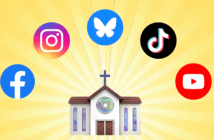Are you and your church growing weary of so many online encounters? There are different ways of connecting safely that don’t involve staring at a screen, writes F. Douglas Powe, Jr., director of the Lewis Center for Church Leadership and James C. Logan Chair in Evangelism (an E. Stanley Jones Professorship) at Wesley Theological Seminary.
The past few months have been a nonstop roller coaster ride for individuals and congregations. So many things we have taken for granted have turned upside down. Most of us could never have imagined a scenario in which we could not safely meet in person and gather as a faith community. But the bad news is that it really isn’t safe to do so in most places.
The good news is that most of us have adapted to some form of virtual worship, meetings, and gatherings. Let me say, I am a big proponent of virtual gatherings. But spending hours working online can become a bit overwhelming, especially when church and family gatherings are also happening online. To be honest, I am experiencing online fatigue, and I expect many others are as well.
I want to connect with others safely but in ways that don’t always require looking at a screen. Let me suggest a few ideas for different ways of connecting safely during these challenging times.
1. Parking lot gatherings
When I go to pick up my morning coffee, I notice a small group of individuals in the parking lot talking at a safe social distance. Prior to the pandemic, this small group of four would gather inside the coffee shop every day to share what was going on in their lives and greet the returning patrons. They can no longer gather inside the shop, but they’ve found a way to keep the practice alive by gathering in the parking lot to talk and greet other patrons.
Getting together in the church parking lot and observing social distancing protocols in groups of five or less is one way to connect in a more personal way. It is a way for people to share stories with others who are an important part of their journey. This way of catching up and connecting can be cathartic for those seeking time away from a screen. It is also an opportunity to reclaim the practice of small group prayer meetings, praying for those in the group and others.
2. Writing handwritten notes
How long has it been since you received a handwritten note on a card or stationery from a loved one? There’s something special about a handwritten note that makes us feel closer to the writer. The reason so many people hang on to handwritten notes is because of the connection it creates with the sender. When we receive such a note, we know someone was thinking about us and took the time to write in a world where instant messaging is the norm.
During these chaotic times when you’re not seeing as many congregants face to face, take the time to write short notes. It is another way of connecting that can be cathartic for both the writer and receiver. Perhaps you could write one note a week to a different person in your congregation to let them know you are thinking about them and share what’s happening in your life. Such notes are a reminder of what we’ve shared as individuals and an opportunity to dream about where God is leading us in the future.
3. Make a phone call
Sometimes it is hard to remember that we can actually talk on our cell phones. We communicate in so many other ways nowadays that we often neglect picking up the phone just to talk with someone. I don’t mean a business call or a call asking someone to do something. I mean calling just to check on someone and to find out if it is well with their soul. I recently received a call from someone I haven’t spoken with in years. And I was pleasantly surprised to find that when we start talking it is like we had never lost touch.
In the midst of this pandemic, many are challenged by loneliness. While a phone conversation isn’t the same as meeting face to face, it is an opportunity to make a personal connection with someone familiar. Make it a practice to phone at least one person a week in your congregation to see how they are doing, not for church business. A phone conversation can go a long way.
I am grateful for the ability to connect online in various ways with others. But in the face of growing online fatigue, it’s important to remember that there are many ways the church community can connect safely that don’t happen over a screen.
Related Resources
- Staying Connected in a Time of Social Distancing by Doug Powe
- Committing to a Hybrid Model of Ministry by Tom Berlin
- Communicating in a Crisis by Mike Bonem






